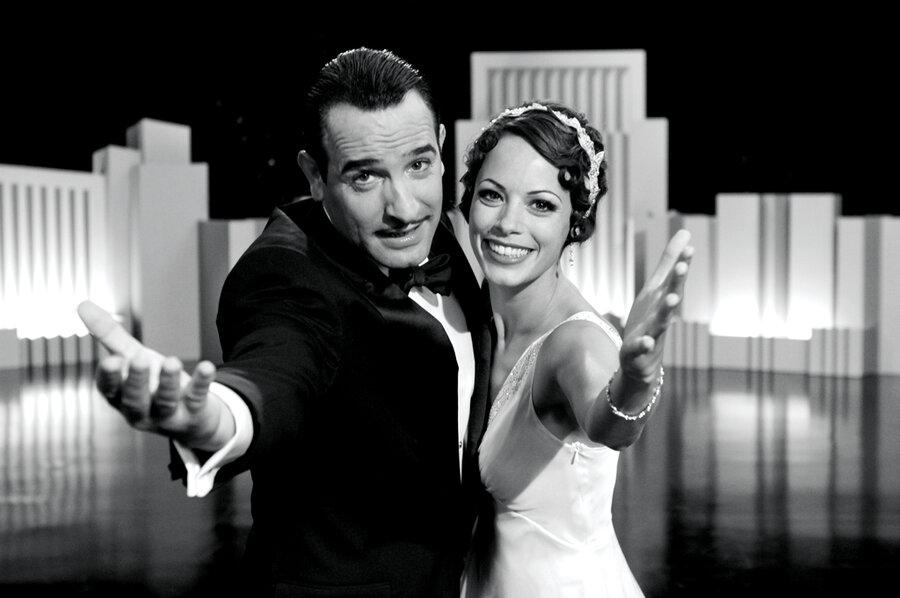The Artist: movie review
A s someone who bemoans the marginalization among moviegoing audiences of our great silent-film heritage, I wish "The Artist," a new black-and-white French film that is almost completely silent, nothing but the best. At least in theory I do. I hope it encourages people to go back and revisit, or in many cases visit for the first time, the glorious wealth of silent cinema available on DVD. But, as adept as "The Artist" is at recapturing the feeling of the early Hollywood silents, it's essentially a faux silent film – a stunt.
Pencil-moustachioed matinee idol George Valentin (Jean Dujardin), hale and limber, is in the swashbuckling Douglas Fairbanks mold, with a bit of Rudolph Valentino and John Gilbert thrown in. We first see him in 1927 emoting in an action-adventure movie-within-a-movie. Then the houselights inside the movie palace playing the film come up and we move outside to the red-carpet première, where aspiring actress Peppy Miller (Bérénice Bejo) captures his eye and, eventually, a small part in his next film. She also captures his heart, although he remains tethered to his exasperated wife (Penelope Ann Miller).
Peppy is equally smitten with George, but writer-director Michel Hazanavicius is careful to portray her in virginal tones. Her love for George, though she might have hoped otherwise, is platonic. As her star rises, his falls. Unable to cope with sound films, George sinks his own money into an expensive silent flop, then gets finished off by the Depression. He ruefully dismisses his faithful chauffeur (James Cromwell). Forced to auction off his personal effects after his wife leaves him, he takes up residence in a dingy apartment with only his adoring Jack Russell terrier and the prints of his films to keep him company.
In a symbolic act of despair, he sets fire to those prints. Were it not for his intrepid terrier, George would also have gone up in smoke. It is at this point that Peppy, whose big hit is a film called "Guardian Angel," proves herself worthy of that title, nursing George back to his senses – and his career.
It's a big, beribboned heart-tugger of a movie and Dujardin, who won the best actor award this year at Cannes, is a charming mimic of silent-film physicality. He knows how to inhabit a role while also spoofing it. In the "OSS" comedies he made with Hazanavicius, he was a poor man's Sean Connery – a fatuously dopey 007. In "The Artist," he conjures up Fairbanks and all the rest with such panache that it's not a stretch to think he might actually have been a star back in the silent era. And Bejo, a Brazilian actress who in real life is partnered with Hazanavicius, has the fresh-faced incandescence that is the emblem of the great silent-movie maidens (Gaynor, Gish, et al).
Still, despite its sweetness and its adherence to period authenticity, the silent-film conceit here began to wear on me. Hazanavicius is content to simply replay silent-movie tropes rather than refresh or rework them. Yes, the film is projected in the correct aspect ratio of the silent era, with occasional title cards inserted. It was shot on Warner Bros. sound stages and filmed at 22 instead of 24 frames per second, for that slightly jerky effect. But its black-and-white look is too glossy for that era. (It's more redolent of the swankier 1940s and early '50s movies.) Hazanavicius also makes the mistake of piping in swelling music from Hitchcock's imperially doomy "Vertigo," of all films, at a crucial point in the romance.
"The Artist" is full of homages to many other films. I suppose it will be fun for cinéastes to pick out the references, but not all of them – like the ones from "Citizen Kane" or "Sunset Boulevard" – are especially germane.
My larger problem with "The Artist" is its essence. Hazanavicius has stated that silent films are all about music and feeling and sensations. The notion that silent movies are movies in their "purest" form – and therefore more "artistic" than movies encumbered by all that dialogue – is not one that I subscribe to. (For one thing, too many of my favorite films have people talking in them.) But even if you agree with Hazanavicius, what is there in "The Artist" that is so artistic? The film offers up a vision of the silent-film past that is essentially a stroll down memory lane. Those memories are concocted for audiences who regard the silent era, if they regard it at all, as a quaint precinct of bedewed sentimentality.
So, to return to my original question, will this movie make people want to see the real deal? Will there now be a revival of Fairbanks classics? Will audiences seek out Chaplin, Keaton, and D.W. Griffith films? Will they clamor to see "Sunrise" and "Greed" and all the other great silents? If they do, they might discover that there was a lot more to silent films at their height than you would ever guess from this amiable little homage that evaporates as you're watching it. Grade: B (Rated PG-13 for a disturbing image and a crude gesture.)





